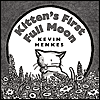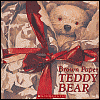|

Henkes, Kevin. 2004. KITTEN'S FIRST FULL MOON. New York: Greenwillow
Books. ISBN: 0060588284
KITTEN’S
FIRST FULL MOON by Kevin Henkes is a Caldecott winner for 2005. It is a warm and fuzzy picture book about a little kitten
that mistake’s the moon for a bowl of milk. She races, pounces, climbs,
and tumbles in search for the bowl of milk. Kitten struggles all evening trying
to reach the bowl of milk. She spots a pond and thinks it is a bowl of milk. She
jumps and ends up wet and tired. After
being unsuccessful and frustrated she returns home to the front porch. A full
bowl of milk awaits her. Young readers will delight in the repetition of “Poor
Kitten.”
KITTEN’S
FIRST FULL MOON is illustrated with painterly media. Mr. Henkes has used gouache
and pencil artwork to bring alive the thick black lines around the bowls of milk. This
is even carried through on the endpapers. The black and white theme is very effective for the night time story.
This particular
book is very unique from Henkes’ past work. The lively watercolors and
ink technique in LILLY’S PURPLE PLASTC PURSE or WEMBERLY WORRIED were vibrant. The black and white pages are very appropriate
for the night time setting of the story.
I liked the ingenuity of the
story and the warm fuzzy feeling of the “poor kitten.” The kitten’s
response was, “What a Night!”
School Library Journal explains, “The rhythmic text and delightful
artwork ensure storytime success. Kids will surely applaud this cat’s irrepressible
spirit.”

Van Allsburg, Chris. 1988. TWO BAD ANTS. New York:
Houghton Mifflin. ISBN: 0395486688.
TWO
BAD ANTS by Chris Van Allsburg is a picture book about adventurous ants that leave their hole to find more white crystals
in a kitchen. Each of the ants select a crystal and start their journey home except for
two curious and greedy ants that decide to stay behind and inspect the new environment.
The two ants eat and eat and fall asleep in the sugar bowl. The next morning
they are awakened by a large scoop. The bizarre journey begins with a trip in
a cup of boiling brown lake, a hot visit inside a toaster, a sudden shot out of the toaster, a cool swim in a falling stream
of water, a bumpy ride in the garbage disposer, a shock from an electric outlet and then the common sound of footsteps from
their fellow insects. They find comfort in knowing their family came back and
that they would be following them home this time.
The illustrations by Mr. Van Allsburg are black and white images with
touches of red, orange, brown, steel blue, and crème. The moods of the illustrations
are dictated by the colors. The courageous ants are experiencing their new world. The dark walk through the cornstalks are drawn in black outline and colored a steal
blue color. This shows the spooky night walk.
The fireflies make light through the stalks. The perspective Mr. Van Allsburg uses to illustrate the ants small size
next to the tallness of the stalks is informative. The reader certainly can feel and see the ant’s perspective that
Van Allsburg has portrayed in his illustrations. Viewing the ants as they swim
in the brown liquid/coffee was like a muddy ocean. As the ants were spinning
in the garbage disposer, the reader could feel and see the sloshing and bumping around they were experiencing. The two ants
feel asleep and were thrilled to hear the familiar sounds of footsteps.
I tend to agree with the School Library Journal review, that this story
will be more enjoyed by older readers. I read this story several times and felt
that prior knowledge would be needed to understand and interpret the illustrations and the text. For example, would a young reader know that white crystal was sugar; hot brown liquid was coffee; and waterfall
pouring from a silver tube was water faucet? I am not sure they would.
I liked the story and the fascinating illustrations. It is a strong story about family staying together from an ant’s perspective.

Allison,Catherine. 2004. BROWN PAPER TEDDY BEAR. New
York: Scholastic. ISBN:043963900X
BROWN PAPER
TEDDY BEAR was written by Catherine Allison and illustrated by Neil Reed. This
delightful Christmas story weaves a story about Jessica and new found imaginary friends. A
small magical door opens in her bedroom and there she peers at a wooden box. She
gets out of bed and takes a look. To her delight it is filled with a “collection of dusty old things: a train with a bell, three blocks, a drum, two books, an old hat,
a cool old car, a racket and ball, and a teddy bear wrapped in a brown paper package tied with a red ribbon.”
Jessica unwraps the package
and finds a soft, cuddly bear. He invites her to take a magical flight to meet
his friends. Jessica dances with a doll, rides the train, marches with
the soldiers, and plays with the puppy. Soon it is time to go home. The next morning her grandfather hears about her journey
and he smiles and says, “I see you found my teddy bear.”
The illustrations by Neil Reed really bring the “old timey”
feeling to the story. The pages are made from heavy brown paper, much like the
color of butcher paper, but the texture is like cardstock. The oversized book is attractive for the Christmas holidays. The realistic pictures are painted in blues, reds, browns and even golden highlights
on Jessica’s hair. The red satin ribbon has a shimmer also. Mr. Reed’s artistic touches really make the drawings touchable.
The story is simple but would appeal to 3-6 years old. Jessica has a magical journey in her plaid pajamas that brings memories to us all when we were younger.
Cummings, Pat.1995. TALKING
WITH ARTISTS, Vol 2. New York: Simon & Schuster Books for Young Readers. ISBN 0027242455
TALKING TO ARTISTS by Pat Cummings
is a very insightful book. I would like to focus mainly on Brian Pinkney and
David Wisniewski. Both artists have different styles and come from very different creative backgrounds.
Mr. Pickney wanted to be an illustrator like his father. He worked with paintbrushes and drew with pencils whenever he had a chance. His
teachers were supportive of his interest in art and they encouraged him. He learned
how to use the scratchboard technique for his illustrations. His ideas come “from
books I’ve read, experiences I’ve had, things I’ve seen.” Pg. 72
He walks with his sketch book with him all the time, and thinks about ideas wherever he is. Mr. Pickney often uses oil pastels and oil paint as his media.
David Wisniewski became an artist through a different avenue. He used to draw “bubble men a lot, especially with spearguns and air tanks in dramatic underwater
battles with huge sharks. I didn’t see the need for faces or fingers. I was thrilled just to have shown action.” page 82. Mr. Wisniewski enjoyed school, drawing with friends, and the performing arts. The circus is where his artistic talents began to surface. He
learned juggling, unicycling, mime, makeup, and acrobatics. He then branched
out with puppetry. The performing art area led him eventually into freelance illustrations. A
quote from this book by David, “Be patient with yourself as your talent develops, then use it to help others.”
Pg. 84
I feel this book brings awareness of many art approaches and the numerous
types of artists. Techniques vary from artists to artists as do their backgrounds.
I like the format Pat Cummings used in her book about artists. The questions
and answers are very informational. Mr. Pickney wanted to be an illustrator from
the beginning and continued with that pursuit. Mr. Wisniewski traveled another
route to become an illustrator. His Caldecott winner GOLEM, is a great example
of artistic talent.
|

